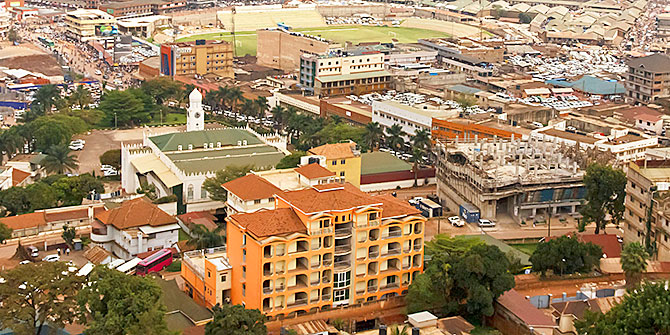This is the second in a series of guest posts from Ato Quayson, Professor of English and the Director of the Centre for Diaspora and Transnational Studies at the University of Toronto. In this post, he examines the peculiar character of the pavement in Accra’s Oxford Street.
Any temptation to see Oxford Street as an almost postmodern transnational commercial boulevard is quickly tempered by multiple cultural phenomena that go back several generations and that appear in varying forms here as well as in different areas of the city and, indeed, in other urban areas in the country at large.

The young man selling fresh coconuts whose skill for discerning the tenderness or hardness of the inner fruit before deftly splitting off the crown with his cutlass seems purely esoteric. The woman who sells ripe plantain roasted over a slow coal fire under a tree on the lively kerbside corner (for strategic reasons, trees and kerbside corners feature prominently in the life cycle of roasted plantain).
The female hawkers nonchalantly walking along with their wares balanced securely on their heads, but without the prop of hands and selling things as varied as ice cold water, or oranges, or roasted peanuts, or even cassava and plantain for the evening’s fufu. One or two of these women may even have a young child strapped to their back.
These variant features bring the mix of businesses and vendors on the Street much closer to commercial districts in other parts of the city such as Makola, Kaneshie Market, Dansoman High Street or Spintex Road, all veritable beehives of commercial activity with their own distinctive characteristics.
Apart from its name and the many businesses found along the street, however, the most visible yet easily missed dimension of the peculiar character of Oxford Street is actually experienced underneath one’s feet, that is, the pavement.
In the 18 December 1926 entry to his Moscow Diary, Walter Benjamin wrote: “It has been observed that pedestrians [in Moscow] walk in “zigzags”. “This is simply on account of the overcrowding of the narrow pavements; nowhere else except here and there in Naples do you find pavements this narrow. This gives Moscow a provincial air, or rather the character of an improvised metropolis that has fallen into place overnight” (Benjamin, 1986: 31).
Even though Oxford Street cannot be said to have materialised overnight from the sky, it is true that here too one is forced to walk in zigzags. But this is not merely due to the narrowness of the pavement. For the Oxford Street pavement is marked first and foremost by its almost determined evanescence as a sidewalk (i.e. it looks like anything but a pavement) and the fact that the distinction between it and the tarmac roadway itself has been practically obliterated.
One reason why the pavement does not look or feel like one is that as Oxford Street evolved into the high-energy commercial street that it is today, the pavement progressively became not the broad strip specifically designed for pedestrians to traverse, but merely a stripped-down extension of the interior of the commercial enterprises along the street. Thus, various businesses on Oxford Street have actually taken over by the pavement in front of their premises, either in terms of the customer parking extending from demarcated parking areas, eg Frankie’s or Ecobank, or simply they sprawl their manufactured goods onto it, such as in the case of the many electronic, hardware and bicycle stores along both sides of the street.
The colonisation of the pavement by commerce from shops and stores is augmented by the presence of vendors of various kinds, both itinerant and stationary. Vendors peddle a variety of items: secondhand clothes, bags and shoes; fruits of all vintage, but with fresh mango, papaya and pineapple to be peeled, sliced or diced up on the spot; Coca-Cola and Sprite in blue ice buckets; red snapper caught fresh from the sea, and at the seashore sold by women but along Oxford Street mongered by young men connected to fishing communities. Pushcarts with various goods abound and there are also vendors of newly manufactured products covering everything from dog chains and flashlights to soccer balls, shoe polish, toothpicks, vibrators and pornographic DVDs.




